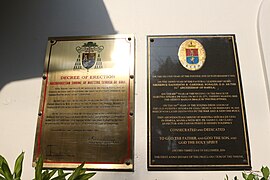Ermita Church
| Ermita Church | |
|---|---|
| Archdiocesan Shrine of Our Lady of Guidance | |
La Ermita de Nuestra Señora de Guía | |
 Façade | |
 Ermita Church | |
| 14°34′43″N 120°58′47″E / 14.5786°N 120.9798°ECoordinates: 14°34′43″N 120°58′47″E / 14.5786°N 120.9798°E | |
| Location | Manila |
| Country | Philippines |
| Denomination | Catholic |
| Website | ermitachurch |
| History | |
| Former name(s) | Hermitage of Our Lady of Guide |
| Status | Shrine |
| Founded | 1606 |
| Cult(s) present | Nuestra Señora de Guía |
| Associated people | Miguel López de Legazpi |
| Architecture | |
| Functional status | Active |
| Heritage designation | National Historical Commission of the Philippines |
| Designated | 1971 |
| Architect(s) | Carlos A. Santos-Viola |
| Architectural type | Chapel |
| Style | Modern |
| Years built | 6 |
| Groundbreaking | 1947 |
| Completed | 1953 |
| Administration | |
| Archdiocese | Manila |
| Subdivision | Vicariate of Nuestra Señora de Guia[1] |
| Clergy | |
| Archbishop | Jose Cardinal Advincula |
| Rector | Very Rev. Msgr. Mario D. Enriquez, PC |
| Vicar(s) | Rev. Fr. Paul Enrique H. Gungon, IV |
The Archdiocesan Shrine of Our Lady of Guidance, also known as Ermita Shrine or Ermita Church (Spanish: La Ermita de Nuestra Señora de Guía) is a shrine located in the district of Ermita in the city of Manila, Philippines. The church is home to the Marian image of the Immaculate Concepcion known as Nuestra Señora de Guía, which is considered to be oldest in the Philippines, and in whose honor the church is officially named after and dedicated to.[2][3]
History[]
The church began as a rustic shrine made of bamboo, nipa, and molave wood that was built to house the image of Our Lady of Guidance in the area where it was found in 1571 by Spanish soldiers under Miguel López de Legazpi. The shrine eventually became a chapel built in 1606 as house for the image and was called La Hermita ("The Chapel" or "Hermitage" in English).[4] The word also gave the name to the present district in Manila where the chapel is located.
The church was damaged many times due to earthquakes. In addition, the image had to be transferred to the Manila Cathedral for safekeeping during the British occupation of Manila in 1762–1764. A more permanent stone church was built in 1810; the image was returned to the church in 1918.[3]
In 1945 near the end of World War II, the church was reduced to rubble during the Battle of Manila. However, the image was saved from destruction and was temporarily kept in a private residence.[5] Work began for the reconstruction of the church in 1947 with a new design by architect Carlos A. Santos-Viola.[6] By 1953, the reconstruction was completed and the image was returned to the new church.
On December 3, 2005, Manila Archbishop Most Rev. Gaudencio B. Cardinal Rosales, DD elevated the status of this church to an archdiocesan shrine.[7]
Gallery[]
old facade
Church interior
Church altar
Nuestra Señora de Guia enshrined in the church altar
historical marker
Archdiocesan Shrine markers
References[]
- ^ "Vicariate of Nuestra Senora de Guia". Roman Catholic Archdiocese of Manila. Retrieved February 26, 2021.
- ^ "About Ermita Church". Ermita Church. Archdiocesan Shrine of Nuestra Señora de Guia.
- ^ a b "Nuestra Señora de Guia, Ermita, Manila". Organographia Philipiniana.
- ^ "ermita". SpanishDict.com. Retrieved on 2015-01-12.
- ^ DeAnda (2009-11-22). "In Honor of Nuestra Señora de Guia". With one's past... Retrieved on 2014-01-12.
- ^ "Malate – Ermita District: Part 3". Manila Nostalgia. July 21, 2013.
- ^ Darang, Josephine (May 15, 2011). "Ermita celebrates 440 years of devotion to La Guia". Philippine Daily Inquirer. Archived from the original on 2014-10-26.
| Wikimedia Commons has media related to Ermita Church. |
- Roman Catholic churches in Manila
- Buildings and structures in Ermita
- 1606 establishments in the Spanish Empire
- Cultural Properties of the Philippines in Metro Manila







